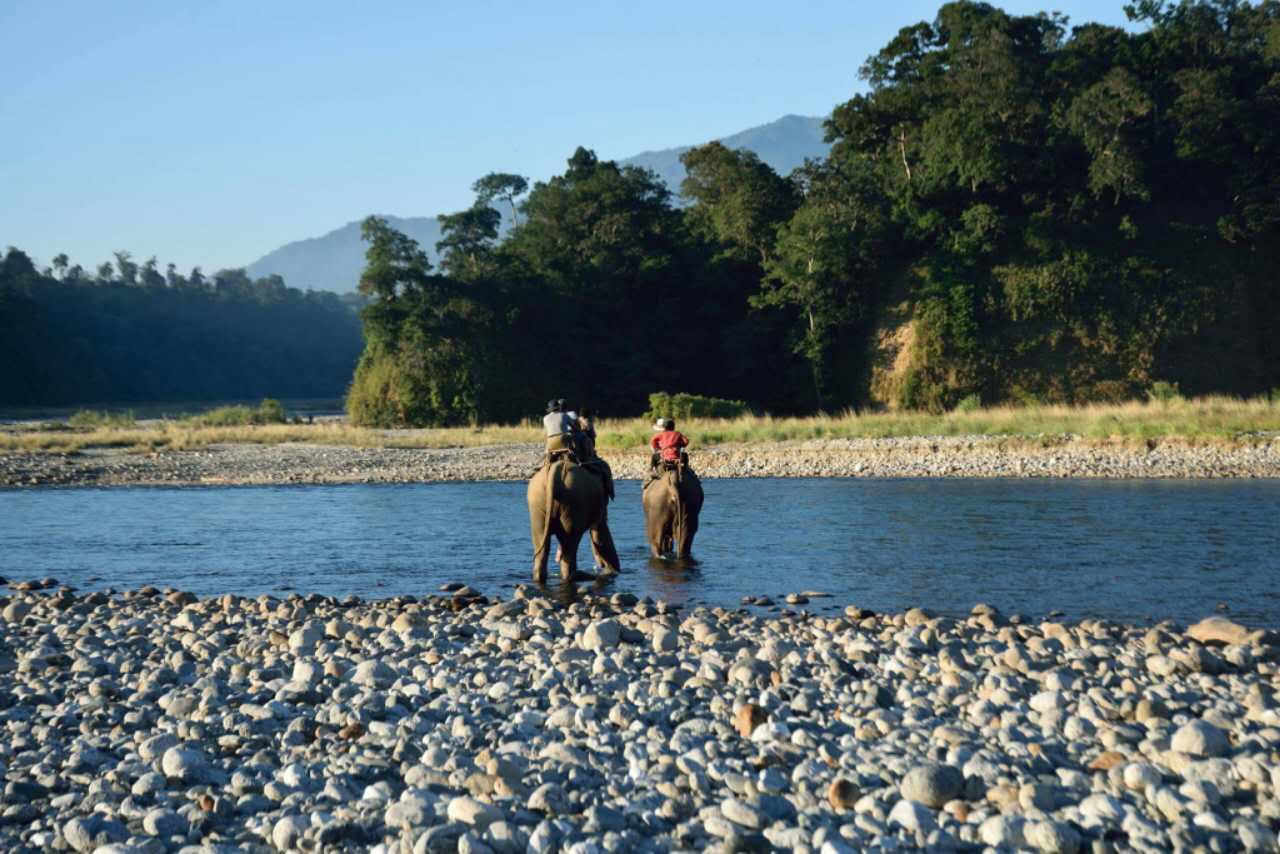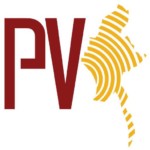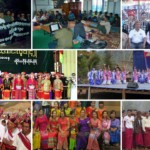By Lama La Rip / Kachinland News | April 10, 2017
Needless to mention that water is a source of life for human being and all life forms, and it is in fact a universal truth. The country of Myanmar
Except Chindwin that originated from within the country, both Ayeyawady and Salween find their origin places in the ice-capped north of the great Himalaya range in China. Ayeyawady in particular got its name when the two tributaries of Mali Hka and N-mai Hka [local name of the two main merging tributaries of Ayeyawady] merge in the place called Tang Hpre village in Kachin state of Myanmar [Burma] the village that symbolizes the beginning of low land part of Kachin state.
The Kachin people consider this confluence as a place of pride for them. When composing songs, writing articles, poems and citations, the Kachin people usually made special mention of this particular place. It is therefore, the confluence is a reason for solidarity among six different clans of Kachin ethnic people [Jinghpaw, Lisu, Laohvo, Lachik, Zaiwa, Rawang].
Millions of ordinary people in the country depend on the Ayeyawady for their livelihood by means of fishing, cultivation, transportation and domestic use. Dozens of big cities and scores of villages in the country are located by the bank of this river, and many shared legendary stories and many historic events of the country have common place in it. It is therefore a source of life and livelihood for millions of ordinary people, beauty for natural lovers and conservationists, and habitat for variety aquatic species particularly rare Ayeyawady dolphin is world famous one, and home to exotic flora and fauna.
Problems begin when profit-making companies, government and ethnic armed organizations that are fighting greater autonomy from the central government started to see the water and rivers not only as life supporting resources but also as profit generating source.
Myanmar being one of the countries in Least Developed Nations (LDC) and in deed is one of the poorest nations in the world, and experience political turbulence of ideological struggle, ethnic armed struggle and mass protest for democracy against successive corrupt and brutal military regimes since the post-independence era. To express condition of country’s development Mr. Wang Ying Fang an Ambassador of China for Asia Pacific Region once made a right remark when he visited Kachin state capital of Myiktyina in November, 2013 during peace talk between Ethnic Armed Organizations (EAOs) and Myanmar Government that Myanmar is much under-developed even compare to many poor African countries he has seen.
It is true that even many big cities in the country have poor electricity supplies, and almost all the rural areas do not have electricity supply even today. According to recent government’s assessment, out of total 10.8 million households government has able to provide electricity supply only to 3.8 million households. Making justification of country’s under-developed and poor electricity supplies first ever attempt to provide electricity to the capital city of Kachin, the then military government of the state built a small hydro-power plant on a small river 20 km north of Myitkyina using forced labour, but finally failed as the hydro power plant was washed away in the flood during a rainy season sometime around 2006.
In the aftermath of three decades long armed conflict in Kachin and northern Shan state, government had able to make peace deals with numbers of armed groups including powerful Kachin Independence Organization (KIO). Fragile ceasefire between government and KIO lasted for seventeen years since 1994 until June 2011. During the seventeen year of ceasefire period instead of seeking for long lasting political solution through political dialogue KIO started initiatives for community development constructing roads, bridges, schools, health centers, and irrigation for farming. The most significant the groups consider themselves was construction of hydropower plant to supply electricity to the Kachin state capital of Myitkyina and country’s northern most town of Putao situated at the foot of Khaka Burazi mountain which is a part of ice-capped the great Himalaya with the permission from central government. KIO in deed succeeded supplying electricity that helped KIO gains appreciation from the local community.
At the same time the then military rulers made lucrative deals with the Chinese government owned companies, Chinese Power Investment Corporation (CPI) in one such company, to construct dams across rivers in Kachin state out of which the proposed dams to be built along the two tributaries up including multi-billion dollar Myitsone Dam at the confluence of those tributaries. This multi-billion dollar Myitsone dam project will be one of the seven largest mega dams in the world that could produce 5000 Megawatt of electricity and could feed multi-million dollar of country’s income from electricity supply to power hunger China. But very upsetting thing of the project is that this hydropower dam would submerge the pristine natural beauty of the area much bigger than the size of Singapore with the area of 18,000 square miles and the height of 152 meter (500 feet) and the reservoir of 299 meter (980 feet). According to the geologists, this dam site falls on the famous Sagaing fault. People fear that in event of devastating earth quake the dam could break and burst to inundate the cities and towns situated along the rivers in the downstream all through the county. This proposed mega dam triggers serious public resentment and consequently fuels series of mass protests throughout Kachin state as well as the whole country.
KIO also lodged complain to the Chinese government through Chinese embassy based in Yangon. The project has already forced displaced couple of villages in the vicinity of the project site as the project started in the early 2000s, and many of households from those villages are already being relocated to newly built village called Aung Mintha and Mali Yang. Following the criticism and mass protests president Thein Sein who was elected in 2010 first ever country’s infamous democratic election finally had to yield to the pressure and announced suspension of the project, but it does not mean total termination of the project.
During my advocacy trip to Beijing in the mid of 2013 with a group of civil society activists, I had a chance to meet with one of the mangers of the China Export Import Bank that financed the project. He said during our meeting, “We have money, and simply keeping money in our bank is meaningless. We have to invest to the project like Myit Sone hydropower project although there risk factors for investment is high. There is already a place – Sichuan province in China to where electricity supply is highly demanding. Your country can earn millions of dollar per year. It is mutual benefiting to both people of your country and China”.
Now that newly elected National League for Democracy (NLD) led by world renown Daw Aung San Suu Kyi holding de-facto premier-like special position called state counselor is under pressure from Chinese government. Before her recent visit to China to have meeting with head of state there, she formed Myit Sone Project Commission to review and due to submit first ever report by November 11, 2016 the president Htin Kyaw. This sparks worries and fears in the mind of general public that the present government’s commission might favour resume of the project.
A Chinese-Myanmar joint hydropower plant on river Ta Ping that flows down from China and meets Ayeyawady at just few miles above Bhamo town, the second capital of Kachin state is another example to highlight how rampant Chinese interest is in developing hydropower plant in the country. Kachin state particularly has numerous rivers and tributaries that flow through mountains gorges and that attract Chinese companies to invest in development of hydropower plants. Due to this reason, many people predict that Kachin can become battery of Asia, second after Lao.
Interestingly this hydropower project falls under KIO controlled area near Yunnan (China) – Myanmar border in Kachin state. The project has been initiated under a secret deal between Chinese government and the then military government of Myanmar without letting know the KIO. Construction started sometime around in 2008 by the Chinese engineers and workers from China. It seems that KIO did not make any complain on the construction with the apparent reason that it is under their control and could make KIO has some share from the benefits. When hydropower plant is nearly finished and about to become operational in early 2011, Myanmar government sent a convoy of army led by high ranking military commanding officer to the project site in the pretext of providing security for the hydropower plant.
KIO objected the move and did not allow the army to reach to the project site which army needs to pass through several out posts of Kachin Independence Army (KIA) the military wing of KIO. After second request from the government army who said that they would just visit the site and return back in a day, KIO finally allowed them to do so, but the government army never come back and instead set up security camp there. Following several back and forth communication between KIO and northern command of government army based in Myitkyina, government sent ultimatum to the KIO and finally launched military operation against KIA on June 9, 2011. This marks the end of seventeen year ceasefire between them and armed conflicts escalated further displacing more than 120,000 people from more than 200 villages across Kachin state and northern Shan state [Source: “Displaced Villages Profiling” by Relief Action Network for IDP and Refugee (RANIR) – 2015)]. According to unconfirmed local sources KIO had a meeting with the responsible persons from the hydropower plant constructing Chinese company and the company paid 12 million Chinese Yuan (Approximately 2 million USD) to KIO in a secret deal.
In the end bliss of nature turns curse for the people of Kachin due to the greed of profit-making business people and companies – domestic and international. Situation remains loom in Kachin state as there is high intention from the Chinese government to resume Thein Sein suspended Myit Sone Dam and present NLD government is apparently facing mounting diplomatic and economic pressure from the Chinese government. The rivers in Kachin state to this end would mean source of life, source of generating country’s income, fueling conflict and bring forth no blessing but untold human miseries and sorrow.
Lama La Rip is an Executive Director of Kachin Development Group (KDG) based in Laiza, the headquarters of the KIO, Kachin State, Myanmar.
This article originally appeared on Kachinland News on April 10, 2017.





